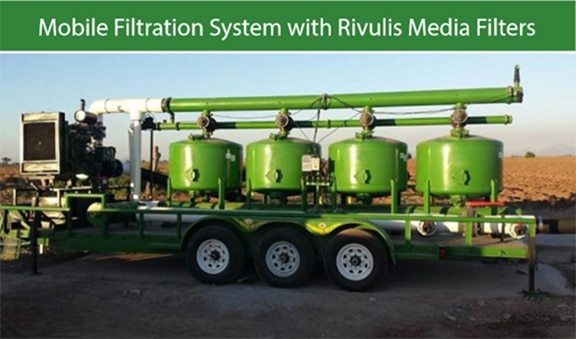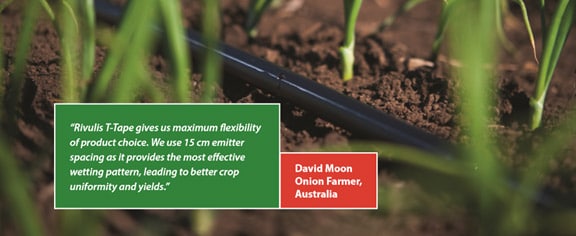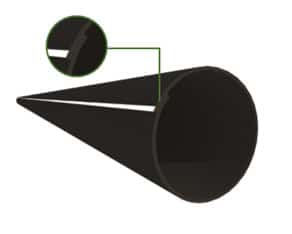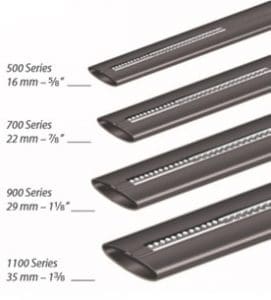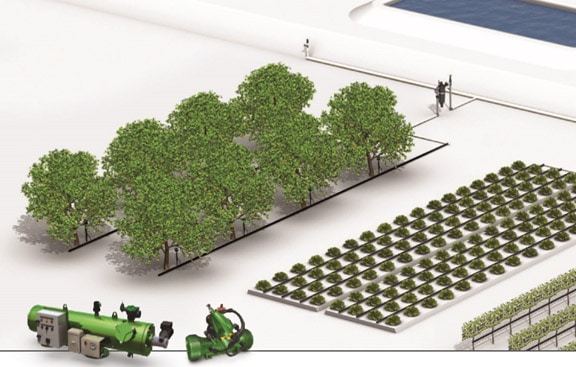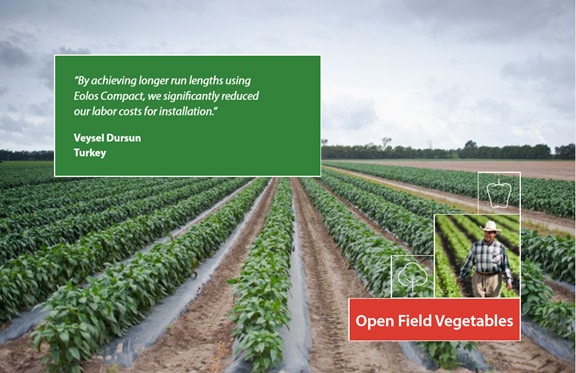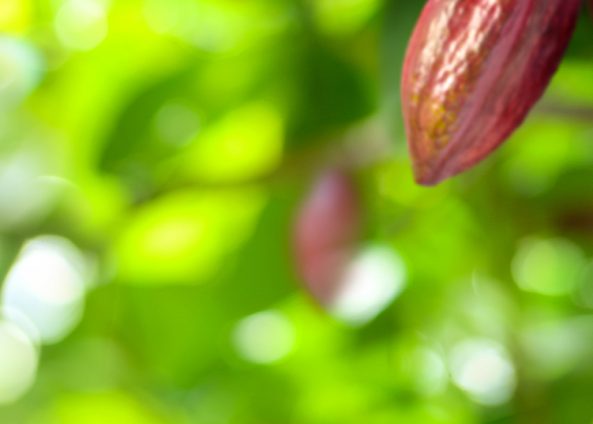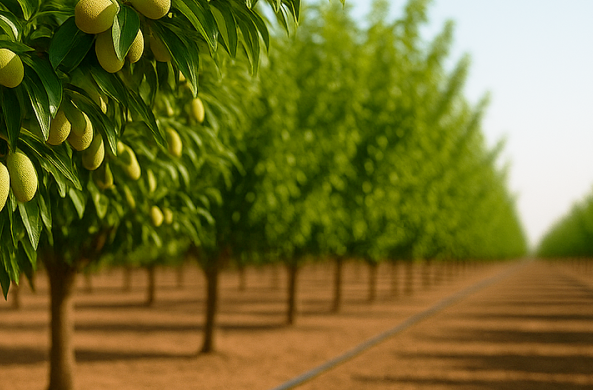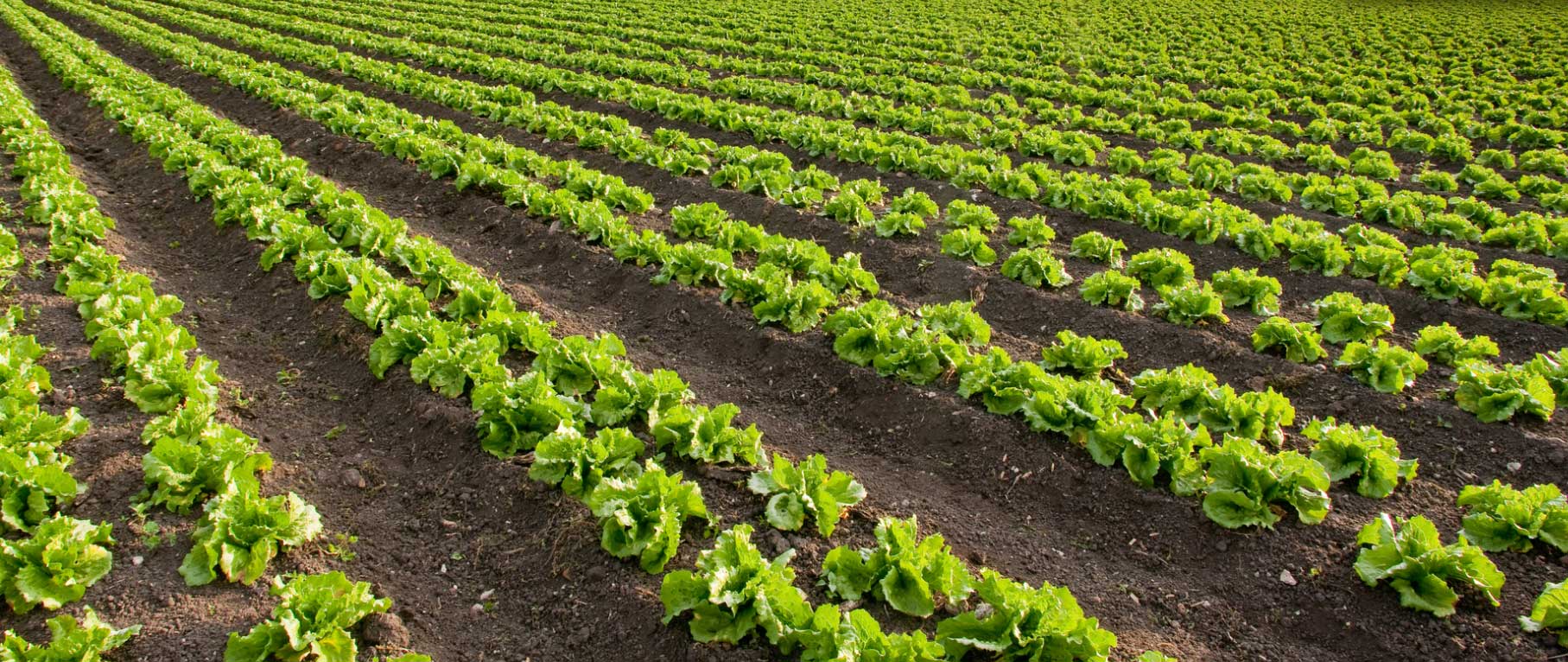
Drip Irrigation for Better Open Field Vegetable Production
Open field vegetables is a wide term and every vegetable has unique requirements. In this brochure, we use the term to define a group of crops that have similar requirements, specifically being that they are grown on a bed irrigated with 1–2 drip lines.
Typical crops include:
- Peppers
- Beans
- Carrots
- Onions
- Brassicas
- Melons
- Eggplants
- Lettuces
- Strawberries
- Sweet Potatoes
The following results can be achieved with drip irrigation:
- Crop uniformity – Consistent water delivery throughout the entire field.
- Crop quality – Does not cause water damage to foliage and vegetables.
- Fertilizer savings – Fertilizer is injected directly into the system.
- Water savings – Irrigate directly to the root zone.
- Light and flexible – Easily change crops and fields each season.
- Don’t irrigate the interrows – interrows make up 60% of the field. Sprinklers irrigate the interrows which encourage weed growth.
- Not impacted by wind – Irrigate even in high wind conditions while maintaining irrigation and crop uniformity.
- Oxygenation potential when water logged – Allows unique applications such as H2O2 injection in shallow subsurface drip applications.
Single Use Drip Tapes for Certainty and Flexibility
A defining feature of open field vegetables is that the drip line is generally single use. Drip lines with a wall thickness of 5 –10 mil are used depending on the amount of insects present and the condition of the soil. Thicker drip lines should be used where there is greater insect risk.
The reasons and benefits of single use drip lines include:
- The value of crop production per m2 is very high compared to most other crops. Single use of each drip line ensures that new drip lines are installed each season.
- Crop cycle is short 70 –150 days. Removes the need for longer lasting (thicker and more expensive) drip lines.
- Crop rotation is common. Select the right drip line for your crop by changing your drip line to best match the unique needs of each crop every season.
- Drip tape is often installed at the same time as plants and plastic mulch.
- Single use drip tape is generally expensed each season the same way fertilizer is.
- Allows for fast setup and portable systems where land is leased. Additional flexibility can be achieved when used in conjunction with mobile system using Rivulis filters (see picture below).
Improve Crop Quality and System Efficiency: Closer Dripper Spacing
Correct spacing between each drip emitter can make a big difference in crop quality and system efficiency. Early drip irrigation systems in open field vegetables used drippers spaced at 40 + cm intervals. However, this practice has generally been superseded by closer dripper spacing of 10 – 30 cm intervals due to the need for more uniform crops and better irrigation system efficiencies. The benefits of closer dripper spacing are numerous, but are all related to more effective water movement. When irrigating, you want water to move laterally, not deep down through the soil profile where it is either lost (including any fertilizers added) or is harder for plants to uptake. By keeping drippers spaced at close intervals, water flows laterally quicker, ensuring a continued wet strip along the row.
Recommended Dripper Interval Spacing
All vegetables except leafy greens 20 – 30 cm | Strawberries & leafy vegetables 10 – 20 cm
Feature Product: Rivulis T-Tape
With Rivulis T-Tape you can experience the benefits of closer emitter spacings without additional cost because Rivulis T-Tape has emitters manufactured into the tape itself, as opposed to inserted molded emitters. That means there is no cost difference per meter between 10 drippers per meter (10 cm spacing) and two drippers per meter (50 cm spacing). Rivulis T-Tape helps make your choice of emitter interval spacing an agronomic decision, not one based on your bank account.
Reinforced Design
Due to Rivulis T-Tape’s unique design, the tape is folded and welded over itself, in turn creating a strong seam along the entire length of the tape. Double thickness along the seam helps make Rivulis T-Tape stronger and therefore easier to retrieve in the field. In addition, the seam provides an extra layer of protection to the emitter. Rivulis T-Tape is designed to snap instead of stretch, with the seam design helping protect the in-built emitter from damage, both during installation and retrieval.
Wide Range of Rivulis T-Tape Configurations
7 x Flow Rate Options: From 0.25 l/h – 4.0 l/h Choose depending on your individual crop, environment and soil requirements
8 x Wall Thickness Options: 4 – 15 mil (0.10 – 0.38 mm) Heavier wall thicknesses are ideal for multi- season, long-term subsurface, or where additional strength is required
4 x Diameter Options: 16, 22, 29 & 35 mm Larger diameters allow for longer run lengths while still achieving high uniformity
Typical Drip Irrigation System Configuration
Pump Station
- Pump
- Primary filters: Rivulis screen / media filters (depending on application) to provide protection to the whole irrigation system
- Automation & fertigation (if required)
- Recommend a Rivulis ‘stone collector’ or suction strainer pre-pump to help protect your system
Filters & Valves
Primary filtration and valves
Generally housed in the pump shed
- Provide filtration and control for the entire system
- Use Rivulis metal valves in the pump shed
- Secondary filtration and valves
- Located in-field
- Valves control individual / sets of blocks. The Rivulis plastic valve range is ideal for in-field application
- In-field filters provide back-up in case something goes wrong in the main line. Rivulis plastic filters provide economical protection for your drip irrigation system.
Main Lines & Sub Mains
- Main lines take water to your blocks and sub-mains to the laterals (i.e. the drip line)
- New main lines are generally PVC and buried underground
- Sub-mains are generally either PVC or poly, buried underground or lay flat above ground
- Remember to install Rivulis combination air valves throughout to allow air to escape on start up, and to prevent your irrigation system from imploding on shut-down
Drip Lines
- Rivulis T-Tape, Ro-Drip, D1000 and Eurodrip Eolos Compact or Eolos (also known as drip laterals in irrigation designs) are installed either on-surface, subsurface or under plastic mulch.
- Diameter, wall thickness, spacing and flow rate will depend on your soil, crop, topography and water quality . We can help you choose a drip line / drip tape configuration suited for your crop.
Feature Product: Eurodrip Eolos Compact
For maximum run lengths, the Eolos Compact drip line is your optimum solution. Each dripper is designed to cause minimum friction and to also provide high level of uniformity throughout the drip line allowing you to have longer rows than most other thin wall drip lines.
**REMARK:
Case study outcomes are for information purposes only and actual results may vary. This literature has been compiled for worldwide circulation and the descriptions, photos, and information are for general purpose use only. Please consult with an irrigation specialist and technical specifications for proper use of Rivulis products. Because some products are not available in all regions, please contact your local dealer for details. Rivulis reserves the right to change specifications and the design of all products without notice. Every effort has been used to ensure that product information, including data sheets, schematics, manuals and brochures are correct. However information should be verified before making any decisions based on this information.



